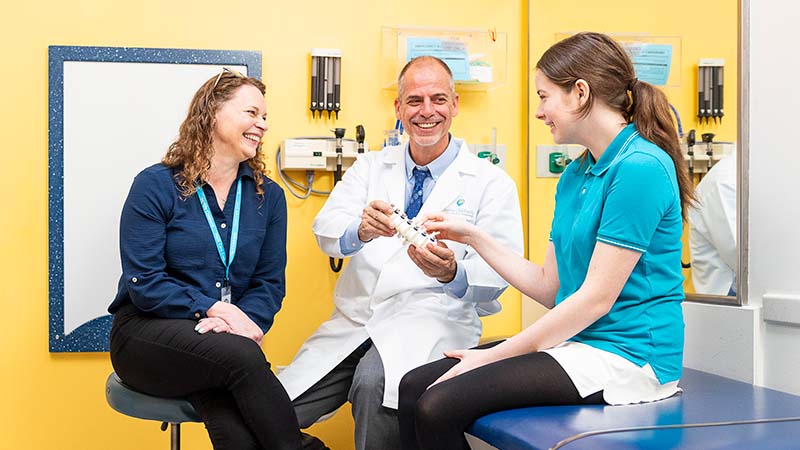Scoliosis
Contact the Spine Program
What is scoliosis?
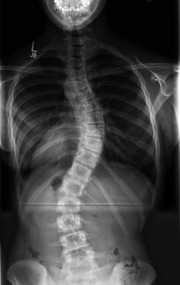
Scoliosis is a sideways curve in the spine. It can affect your child’s rib cage as well as their spine.
Scoliosis (sko-lee-OH-sis) is a sideways curve in the spine. On an taken from the front or back, most children’s spines look straight. In children with scoliosis, the spine curves to the side, like the letter C or S.
Many children have slight side-to-side curves in their spines. They usually do not need treatment. In those with scoliosis, the bones of the spine (vertebrae) have a curve larger than 10 degrees.
Equal numbers of boys and girls have the smaller curves that need no treatment. Girls are 7 times as likely as boys to have larger curves in their spines.
What causes scoliosis?
There are many possible causes of scoliosis. Some children develop a curve in their spine because of the way their vertebrae formed before birth. Others have a muscle or nerve condition that affects the shape of their spine. Sometimes scoliosis is just one aspect of a larger that has other health effects, too. In some cases, doctors cannot find any clear cause for scoliosis.
Spine Program at Seattle Children's
Types of Scoliosis
There are many types of scoliosis. Finding out what type your child may have is important. This matters because the types change in different ways over time and need different scoliosis treatments.
Idiopathic scoliosis
Idiopathic means we do not know the clear cause of the problem. There is no known problem with the bones, nerves or muscles that causes the curve. This is the most common type of scoliosis in adolescence. It is less common in babies and young children. Based on your child’s age, doctors might call this infantile, juvenile or adolescent idiopathic scoliosis.
About 2% of children have idiopathic scoliosis. In most, the curve is small and doesn’t need treatment. Only about 2 in 1,000 children have a curve large enough to treat.
Congenital scoliosis
In this type, some vertebrae are not shaped normally from birth. As your child grows, these vertebrae don’t grow normally. The way the bones grow causes a sideways curve.
Neuromuscular scoliosis
Problems with the muscles or nervous system may cause the spine to curve. Examples are , or a spinal cord (syrinx).
Reactive or functional scoliosis
Sometimes a child will bend their back to the side in response to back pain. The child’s curve is flexible. It will go away if the problem that causes them to bend goes away.
Syndromic scoliosis
Some children have scoliosis as part of a larger syndrome that affects the muscles and bones. Examples include Marfan syndrome, neurofibromatosis or Prader-Willi syndrome.
Traumatic scoliosis
A fracture of the spine or a spinal cord injury causes this type of scoliosis.
Degenerative scoliosis
In this type, the curve forms because disks and joints in the spine are worn down. Usually, this type affects older adults.
What are the symptoms of scoliosis?
You may notice 1 or more of these symptoms:
- You can see a C-shaped or S-shaped curve in your child’s spine. (When curves are smaller, they may be harder to see.)
- One of your child’s shoulders is higher than the other. (A slight difference is common in people who do not have scoliosis.)
- One of your child’s shoulder blades sticks out of their back when they are standing.
- Your child’s waist looks higher on 1 side.
- Your child’s chest looks larger on 1 side. People with breasts may notice that 1 looks larger than the other.
- In some children, the whole trunk may shift to the right or left. They may look like they are leaning to 1 side.
Is back pain 1 of the symptoms of scoliosis?
Many children have mild back pain. Scoliosis does not usually cause back pain. But some things that cause back pain may also cause scoliosis.
How is scoliosis diagnosed?
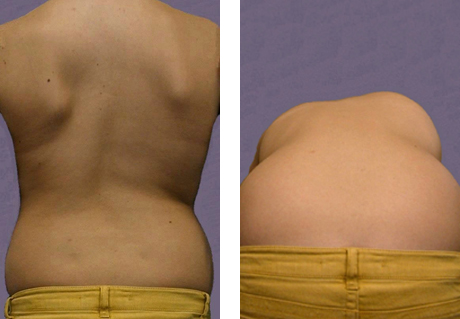
Left: Teen with scoliosis. Right: How their spine looks when bending forward.
To diagnose scoliosis, your child’s doctor will ask about your child’s medical history and growth. They will look at and feel your child’s spine for signs of scoliosis. They may ask your child to bend forward for the exam. Until scoliosis is over 30 degrees, it can be hard to see when your child is standing. Curves are easier to see when your child bends forward because of the way the spine and rib cage turn.
To confirm the diagnosis or check for other problems, your child may need imaging. This might include an X-ray, or .
How is scoliosis treated?
There are many treatments for scoliosis, and Seattle Children’s Spine Program offers the most advanced options. These can include surgical and nonsurgical options to correct a curve or keep it from getting worse. We have treated thousands of children with scoliosis.
If your child shows early signs of scoliosis (mild symptoms that concern you), talk with your child’s doctor. We are concerned about small curves in children because they can quickly get worse during growth. When children have a larger curve and still have a lot of growth left, there is a good chance the curve will get much bigger. If a child has mild scoliosis and there is not much growth left, there’s much less chance of the curve getting bigger.
The goal of scoliosis treatment is for your child to reach the end of their growth with a curve small enough that they are not likely to need surgery and the curve is not likely to get bigger.
Nonsurgical Treatments for Scoliosis
For most children, we can successfully treat scoliosis with nonsurgical methods. The most common treatments we use are observation and bracing. Sometimes, we recommend Mehta casting, diet or exercise changes or Schroth physical therapy.
-
Observation
This usually means having an exam and X-ray of the spine every 6 months. If your child is growing fast or their curve is getting worse, they may need an exam and X-ray more often. Scoliosis is more likely to get worse during times of rapid growth, like just before .
To track your child’s growth, it helps to keep a record of their height. Once your child has stopped growing, their spinal curve is less likely to get worse. After that point, we will check them less often.
-
Bracing
A brace is a common treatment for children with curves between 20 and 45 degrees who are still growing. Bracing is not used for children who are done growing.
The brace is used to prevent the curve from getting worse. It will not make the curve go away.
If your child begins treatment with a brace, they may wear it until they finish growing or the curve gets so large that they need surgery.
It’s important to fit the brace to your child’s body. We have a great deal of experience in making braces to fit children of all sizes and ages. Read about braces and our other orthotics and prosthetics services.
-
Mehta casting
If your child is age 3 or younger and needs treatment, we may recommend Mehta casting. This means putting a cast around their upper body. The cast pushes the spine straight.
Keeping the cast on full time gives your child the best chance to grow straighter. The goal is to keep their curve from getting worse — and possibly to make it better. Mehta casting may cure scoliosis in young children who are treated early.
This treatment is not surgery (no cuts are made to the skin). But the cast is put on in the operating room with your child under . Read more about Mehta casting (PDF).
-
Diet, supplements and exercise
Children who have scoliosis may have a higher risk for weak bones (osteoporosis) later in life. Based on your child’s needs, we may suggest diet changes or supplements. We want to make sure they get enough calcium and vitamin D to help keep their bones strong. Check with your child’s healthcare provider before giving them any vitamin or supplement.
It’s also important for your child to get regular weight-bearing exercise. This includes movements like walking or running. Regular play and exercise are good for your child’s health and can help prevent back pain. Gym classes are good for children with scoliosis.
-
Schroth physical therapy
The most common type of physical therapy for scoliosis is called the Schroth method. Seattle Children’s has physical therapists (PTs) trained in Schroth physical therapy. It may help some children with small curves.
With this method, your child learns and practices exercises during visits with a PT. Then they do the exercises every day at home. Read more about Schroth physical therapy (PDF).
-
Other options
You may hear or read about other forms of therapy, such as chiropractic, electrical stimulation, massage or yoga. These do not hurt the spine and may help with back pain. But it’s not clear that they keep scoliosis from getting worse.
Surgery for Scoliosis
Children with spinal curves greater than 50 degrees may benefit from surgery. In rare cases, when a child has a lot of growth left, we may recommend surgery for a smaller curve (40 to 50 degrees).
The goal of surgery is to keep scoliosis from getting worse and correct the curve as much as we can.
Seattle Children’s Spine Program is known nationwide for excellence in all types of spinal surgery for kids. Surgeries for scoliosis take place in our new state-of-the-art operating rooms. The rooms were designed to reduce stress and increase comfort for your child.
Our orthopedic spine surgeons use different types of operations to correct the curve and make the spine stable, based on your child’s needs. All the surgeons are highly skilled with special training in surgery for children’s spines.
Most children have 1 of the surgeries described below.
Spinal fusion
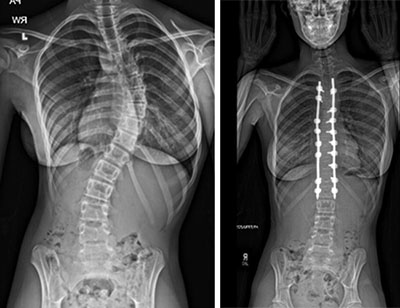
Left: Before surgery to fuse the spine. Right: After surgery to fuse the spine.
The most common surgery for scoliosis is spinal fusion. It straightens your child’s spine. We release some of the and around the spinal cord. Then, we attach metal rods and screws to the bones in the back. The screws and rods are almost always permanent. In rare cases, they may be removed.
In a spinal fusion surgery:
- The surgeon makes a cut (incision) to reach your child’s spine, either from the back or from the side.
- The surgeon puts screws in the bones of the spine. Then, they remove the joints between the bones and connect the rod to the screws.
- The surgeon changes the shape of your child’s spine to make it straighter.
- Then the surgeon tightens the screws so they connect firmly to the rod.
- Finally, the surgeon puts a along the spine to help the bones grow together to form 1 large bone.
Based on results of our research, we fuse the shortest section that we can. This way, your child keeps as much movement in their spine as possible.
Nonfusion tethering, such as vertebral body tethering
This may be an option instead of fusion, or we may use it along with fusion. The surgeon puts anchors in the back bones on the outer side of the curve. They connect the anchors with a cord that can flex. The free (inner) side of the curve can grow more than the side where the cord is. Over time, your child’s growth can slowly straighten the curve in their spine.
Growing rods, MAGEC and VEPTR
This surgery may help if your child is very young, their spine is still growing and a back brace did not help. It uses metal rods to support the spine. The rods can be made longer as your child grows.
As in spinal fusion, the surgeon connects a rod to the bones in your child’s spine. But the surgeon does not remove the joints or fuse the spine with a bone graft.
There are 2 ways to lengthen your child’s growing rod:
- With some growing rods, your child needs surgery about every 6 to 9 months to lengthen the rod.
- With the MAGnetic Expansion Control (MAGEC) system, a surgeon lengthens the rod every few months at a clinic visit. They hold a remote control against your child’s back. Each click of the remote makes a magnet in the rod turn a screw in your child’s body. This extends the rod a third of a millimeter — about the width of a grain of sand.
For very young children who have fused ribs, congenital scoliosis and severe chest wall deformities, we use a type of growing rod called a vertical expandable prosthetic titanium rib (VEPTR). It can attach to ribs or parts of the spine or pelvis.
Our research into severe early-onset scoliosis focuses on how scoliosis affects lung function. Dr. Gregory Redding leads research to help clarify when growing rods are the best treatment for children with scoliosis and lung disease.
Halo gravity traction
Some children with scoliosis and kyphosis need halo gravity traction (HGT) before surgery to correct their spinal curves. This is a way to apply a slow and safe stretch to your child’s spine.
It uses a metal ring that surrounds the head (called a halo). A surgeon puts the halo on your child’s head under . The halo is attached to a pulley system 24 hours a day for several weeks. Weights are added to the pulley system to slowly pull the head upward.
Your child will stay in the hospital during HGT. Read more about HGT (PDF).
Are there Seattle Children’s research or clinical trials for scoliosis?
Members of the Spine Program team are leaders in research on scoliosis. We are always tracking the results of our patients’ care so we can be sure we are choosing the best treatment for each child. Your child’s care team may ask if you want to be involved in research. For example, we may ask to include data about your child’s condition and treatment in our studies.
Learn about research studies and clinical trials at Seattle Children’s.
Why choose Seattle Children’s for scoliosis treatment?
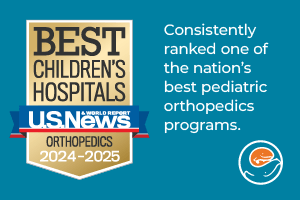 The Spine Program at Seattle Children’s treats all types of scoliosis in babies, children, teens and young adults. As the largest pediatric spine center in the Pacific Northwest, our spine surgeons have more training and experience treating pediatric spine conditions than any other hospital in the area.
The Spine Program at Seattle Children’s treats all types of scoliosis in babies, children, teens and young adults. As the largest pediatric spine center in the Pacific Northwest, our spine surgeons have more training and experience treating pediatric spine conditions than any other hospital in the area.
We offer the most comprehensive care for your child, no matter how complex their condition is. It’s why other hospitals in the region refer their most complex pediatric patients to us.
-
The experts you need are here
- The Spine Program team includes doctors, surgeons, (PAs) and (NPs) from Orthopedics and Sports Medicine. More severe curves may be harder to correct and affect the spinal cord and lungs. In these cases, the team includes experts from Neurosciences and Pulmonary Medicine. They meet as a group to talk about patients’ needs and treatment plans.
- We can successfully treat scoliosis in most children with methods other than surgery. Often, this means a back brace to keep a spinal curve from getting worse. Our onsite orthotists build and fit braces. They see your child at the same visit with your child’s doctor, PA or NP to coordinate your child’s care.
- If your child needs surgery, our orthopedic spine surgeons are leaders in their field. They have more training and experience with children’s complex spine conditions than anyone else in the area. Spine surgery for children is all they do. Each is .
- Spine conditions can affect more than a child’s bones, muscles and joints. That’s why we connect you and your family with any expert your child may need across Seattle Children’s. For example, we may involve Adolescent Medicine, Rehabilitation Medicine, Rheumatology and Pain Medicine.
-
Our approach to surgery increases comfort and reduces stress
- Our new state-of-the-art operating rooms reduce stress and increase comfort for your child. The design lets you stay by your child’s side until they gently go to sleep before any spine surgery.
- Before we recommend surgery, we look at your child as a whole person. Your child’s team will take many factors into account. These include the degree of their spinal curve, the effects on their health and how much more they will grow. We also consider what results you can expect from treatment.
- When were developed in the early 2000s, Seattle Children’s was among the first to offer them for children with a spinal curve. The rods help correct your child’s curve and still let your child grow.
- Seattle Children’s offers the MAGnetic Expansion Control (MAGEC) system. With this system, your child may need fewer surgeries for severe scoliosis. Instead of surgery every 6 months to lengthen their growing rods, your child comes for office visits. The surgeon lengthens the rods using a remote control.
- Our surgeons were among the first to use . This treatment can be used along with or instead of spinal fusion (making bones grow together into 1 bone). It can let children keep more movement in their spine.
- We have the technology and skills to use 3D imaging to guide your child’s surgery, if needed. This helps us place hardware, such as rods and screws, with precision. It also lets us see in real time the changes we make to your child’s spine. Based on your child’s needs, we may use X-rays or .
- We have a dedicated spine anesthesia team. They specialize in keeping children safe and comfortable during spine surgery.
- helps us prevent a spinal cord injury during surgery. Our surgical spinal cord monitoring team leads the country in new ways to make back surgery safer.
-
Care from birth through young adulthood
- We specialize in caring for kids. This means our experts have the knowledge, training and skills to treat the youngest patients through young adults. We have treated many babies with infantile scoliosis and young children with early-onset scoliosis.
- Babies, children and teens are still developing. When we evaluate your child’s condition, design their treatment and provide their care, we carefully consider their growth. We think about how growth may affect your child’s spine over time. We also consider how their spine may affect the rest of their development and health.
- If your child needs imaging that uses radiation, we use the lowest amount possible (PDF) to make the best image. We have a low-dose radiation X-ray machine, called the EOS. It makes safer full-body images. We also have the largest group of pediatric radiologists in the Northwest.
-
Support for your whole family
- We know it can be stressful to have a child with a spinal condition and to find the treatment they need. Everyone at Seattle Children’s works to make your experience here as easy as we can on your whole family.
- Your child’s team does more than plan and provide care for your child. We also make sure you and your child understand your child’s condition and treatment options.
- Care is easier for you because your child’s Spine Program team will include experts from Orthopedics, Neurosciences and Pulmonary Medicine as needed. They work closely with each other and with other programs and clinics your child may need. For example, we often work with the Neuromuscular Program for muscular dystrophy. If your child has cerebral palsy, we work with the Ortho Rehab Clinic.
- Seattle Children’s supports your family with a range of resources. Our Child Life specialists, Family Resource Center and Guest Services are here to help.
-
Research and advances to improve care
- Our spine experts are part of national and international research groups. These groups study the latest treatment approaches and technologies. Together, we work to find the best and safest ways to care for children. We are part of the Scoliosis Research Society, Pediatric Spine Study Group, Harms Study Group and Fox Congenital Spine Study Group.
- Severe early-onset scoliosis, neck problems and congenital spine problems are rare. So, no single hospital treats enough patients to study these conditions well on its own. Through research groups, we join with other top-tier children’s hospitals to find better treatments.
- We developed advances in monitoring and treatment of scoliosis in very young children.
- Seattle Children’s has one of the largest growing-rod programs in the country. We are a leader in studying how growing rods affect children and how well they work.
- Our surgeons have led research to reduce your child’s exposure to radiation from imaging tests, like X-rays and , before and during surgery.
- Learn more about current orthopedics research at Seattle Children’s.
Contact Us
Contact Orthopedics and Sports Medicine at 206-987-2109 for an appointment, a second opinion or more information.
Providers, see how to refer a patient.
Related Links
- Care After Scoliosis Surgery (PDF) (Spanish)
- Orthopedics and Sports Medicine
- Scoliosis (PDF) (Spanish)
- Scoliosis Surgery (PDF) (Russian) (Spanish)
- Spine Program
- More scoliosis resources
Paying for Care
Learn about paying for care at Seattle Children’s, including insurance coverage, billing and financial assistance.

